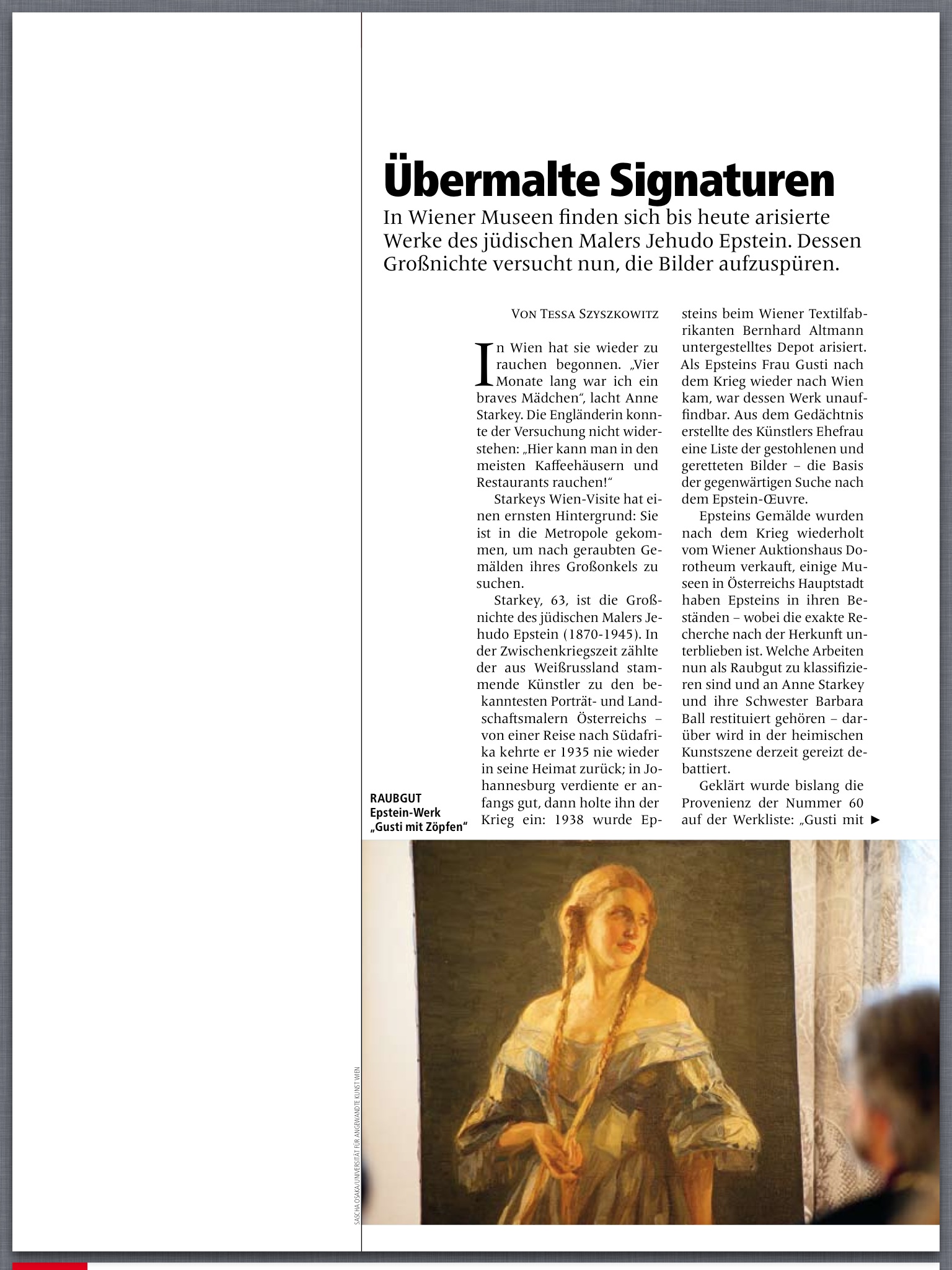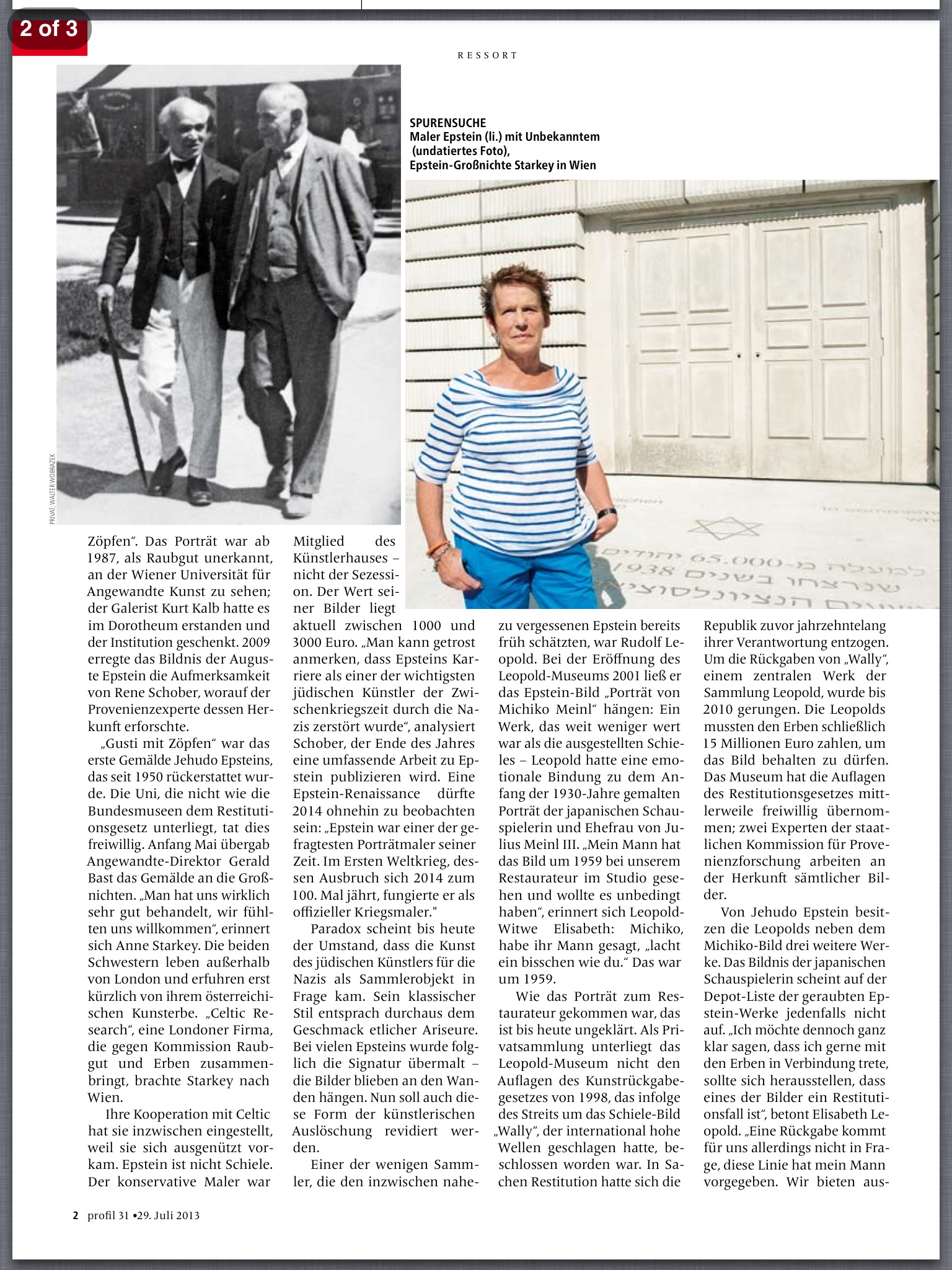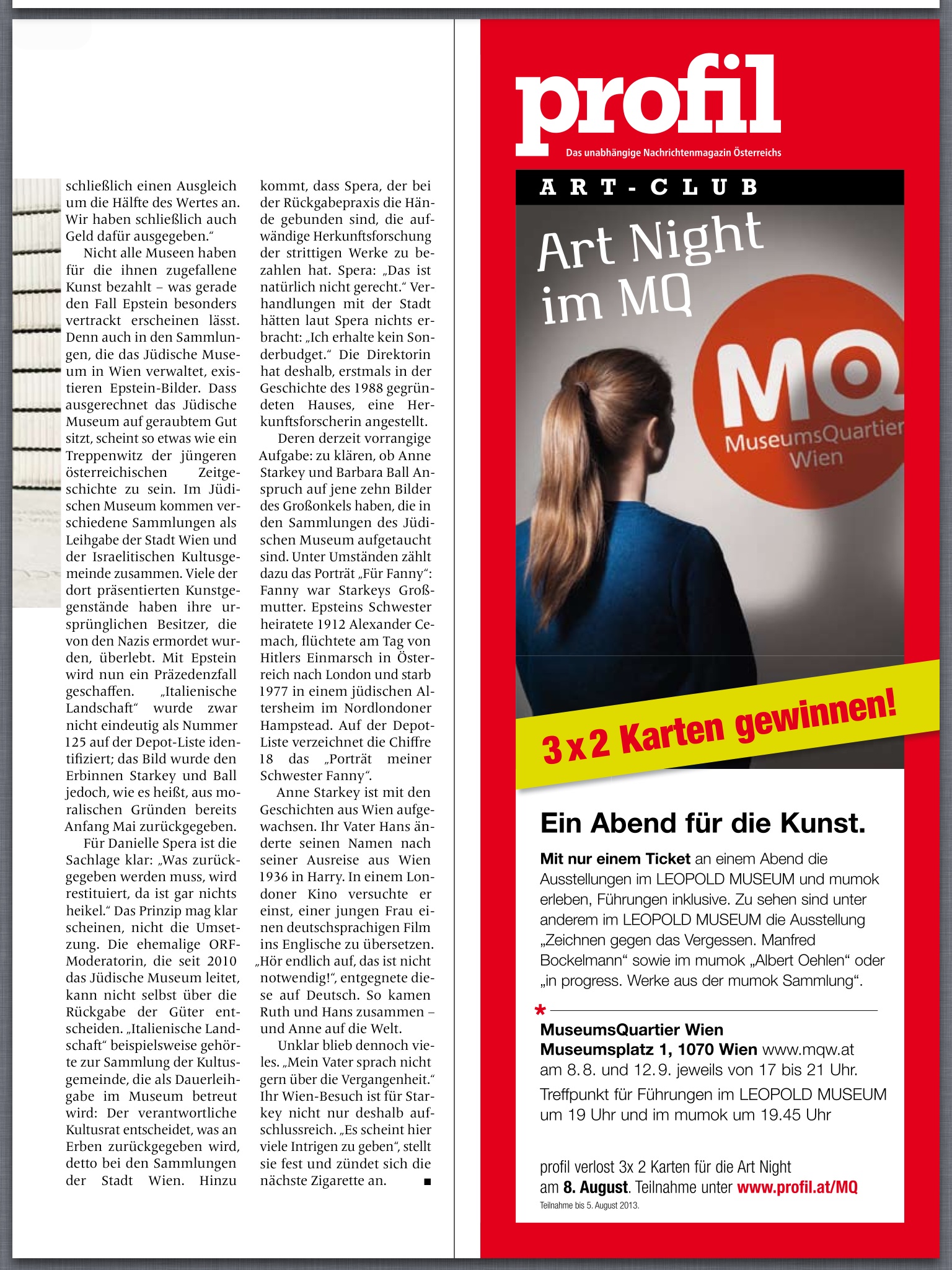News:
Painted-Over Signatures
By Tessa Szyszkowitz
Vienna’s museums still hold paintings by Jewish artist Jehudo Epstein which were looted by the Nazis. Epstein’s great-niece came to Vienna to find them.
The trip to Vienna started her smoking again: “I was a good girl for four months”, Anne Starkey says and inhales, “but here in Vienna people smoke freely in coffee shops and restaurants and I could not resist it.” Maybe it was more than nicotine cravings which prompted her to take up the habit again. The 63-year-old might need something to counteract stress. After all, she arrived in Vienna to look for paintings by her great-uncle which had been looted by the Nazis and might be hanging in various Viennese museums today.
Jehudo Epstein (1870-1945) was a very popular portrait and landscape painter in Austria between the wars. He never returned from a trip to South Africa. Initially, he stayed because he earned better money in Johannesburg, and later he was not able to return because the Second World War had broken out. His entire collection of work, which he left behind in a factory belonging to a textile producer called Bernhard Altmann, was Aryanised (confiscated) in 1938. When Epstein’s widow Gusti came back after the war to claim it, it had vanished. She compiled a list of lost art works which has become the basis of her great-niece Anne’s search.
Several of Epstein’s paintings were sold by Viennese auction houses after the war. Some of the Austrian museums now have them in their collections. Nobody bothered for a long time to look properly into their history. Which paintings will now be established as looted art and will be restored to Anne Starkey and her sister Barbara Ball is currently a hot potato that no museum director wants.
So far, two paintings have been restored to Epstein’s heirs. Number 135 on the list of the painter’s widow was titled “Girl With Braids”. The portrait had been on display in the Viennese University for Applied Arts since 1987. Kurt Kalb, a well-known gallerist, had bought it in the Viennese auction house Dorotheum and donated it to the university. In 2009, art historian and provenance researcher Rene Schober started to look into the painting’s history.
“Girl With Braids” became the first Epstein to be restituted since 1950. The university gave the painting back voluntarily because it is not bound by the restitution laws for national museums as it is a university. At the beginning of May, university rector Gerald Bast returned the painting to its lawful owners, sisters Anne and Barbara, the painter’s heiresses. “They treated us very well, we felt very welcome”, Anne says. The sisters live outside London and only recently learned about the possibility of claiming their uncle’s work through a research company which charges a commission for bringing together looted art and the heirs of its original owners.
The sisters ended up terminating their agreement with the London firm because they said they felt exploited. In any case, Epstein is no Schiele. He was a conservative painter for his time, a member of the Viennese Künstlerhaus rather than the Secession, which housed the avantgarde stars of Viennese painting at the beginning of the last century. Epstein’s paintings sell currently for a mere 1000 to 3000 euros. “We can say that Epstein’s very successful career in the period betwen the two world wars was terminated by the Nazis”, says Epstein expert Rene Schober. He will publish a longer study on Epstein next winter. 2014 promises to bring an Epstein renaissance. His paintings might be shown in exhibitions about the centenary of the outbreak of the First World War. Epstein was an official war painter of the Austrian Emperor at the time.
It is a nice paradox that the Nazis liked Epstein’s conservative style so much that they actually included him in their collections. Usually Jewish painters were considered to be “entartete Kunst”, (degenerate art) and paintings by famous artists like Schiele or Kokoschka were looted and then sold abroad. But Epstein, with his conservative but exquisite style, was to many Nazis’ liking. They kept his paintings on the wall and often removed only the signature. But now, as the provenance of many paintings is being checked, Epstein’s artistic legacy could gain a fresh importance.
One of the few collectors who took a liking to a particular Epstein painting was Rudolf Leopold. At the opening of his Leopold Museum in 2001, he put “Portrait of Michiko Meinl” next to the much more valuable Schieles because he liked the painting so much. It shows a Japanese actress who was very popular in the Thirties and who was married briefly to Julius Meinl III. “My husband saw the painting in the studio of our art restorer around 1958, and said: “Her smile reminds me of you,” Elisabeth Leopold recounts with a smile.
How the portrait ended up with the restorer, nobody knows. Maybe Meinl sold it after Michiko left him. But Leopold’s widow is determined to find out. Austria’s restitution law was adopted in 1998 after all hell broke loose over a restitution case involving one of the Leopold’s most valuable works: Egon Schiele’s “Wally”.
The case lasted from 1998 to 2010 and ended with the Leopolds paying 15 million euros to the painting’s heirs in America. Since then, the Leopold Museum has voluntarily agreed to follow the procedures of Austria’s National Provenance Commission, although its collection is a private one. Two experts from the Commission are currently doing research at the Leopold Museum.
Altogether there are four Epstein paintings there. Michiko’s portrait was not included in Gusti’s list. “But I want to make it very clear that I would certainly meet with the heirs if they have a case,” Leopold’s widow says. “We always offer compensation – half the current value. It is what my late husband thought best. After all, we also paid for the paintings.”
Not every museum paid for their art – this is one of the tricky aspects of the Epstein story. The Jewish Museum in Vienna also has 10 Epstein paintings. They are included in collections which the city of Vienna and the Jewish community of Vienna gave to the museum on permanent loan. That none other than the Jewish Museum hosts art which was looted by the Nazis sounds like a tasteless joke of Austrian history. Many of the items in the collection have survived their original owners, who perished in the Holocaust. Epstein’s work is a case in point. His painting “Italienische Landschaft” was not clearly identified as Number 125 in Gusti’s list but was still returned to Anne Starkey and her sister for moral reasons.
To Jewish Museum director Danielle Spera, some things are clear: “What needs to be returned, will be returned, there is nothing sensitive about that.” The principle is not at issue, but the implementation of it certainly is. Spera, a former TV anchor woman who was named to run the museum in 2010, cannot decide herself about the right course to follow on the restitution of works of art. “Italian Landscape”, for example, was originally part of the collection of Vienna’s Jewish Community.
Any decision about restitution will be taken not by the museum, but by the leadership of the Jewish community. Spera cannot decide but she still has to pay for the research. “That’s of course not fair,” she says. Negotiations with the city of Vienna have not been successful because “they won’t give me a budget for it”. For the first time in the history of the young museum – it was founded in 1988 – she has hired a provenance researcher.
Many things remain unclear to her. “My father did not like to speak about his family history,” she says. But on her trip to Vienna she has not only learned more about her family. She has got an introduction to how Vienna works. “It seems to me there are many intrigues here”, she observes, lighting another cigarette.


 http://www.tessaszy.com/en/859/painted-over-signatures
http://www.tessaszy.com/en/859/painted-over-signatures

